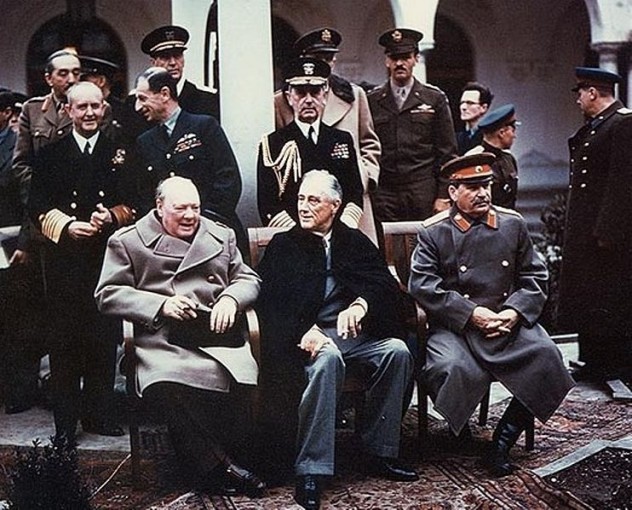 Creepy
Creepy  Creepy
Creepy  Movies and TV
Movies and TV 10 Movies That Get Elite Jobs Right, According to Experts
 Weird Stuff
Weird Stuff 10 Times Real Laws Were Based on Bizarre Hypotheticals
 Animals
Animals 10 Inspiring Tales of Horses Being Human
 Mysteries
Mysteries Top 10 Haunting Facts About the Ghost Ship MV Alta
 History
History 10 Surprising Stories About the Texas Rangers
 Humans
Humans 10 Philosophers Who Were Driven Mad by Their Own Theories
 Miscellaneous
Miscellaneous 10 Video-Game-Worthy Weapons and Armors from History
 Weird Stuff
Weird Stuff 10 Psychics Who Accurately Predicted Wartime Events
 The Arts
The Arts 10 Pieces of Art Inspired by a Broken Heart
 Creepy
Creepy 10 Death Superstitions That Will Give You the Creeps
 Movies and TV
Movies and TV 10 Movies That Get Elite Jobs Right, According to Experts
 Weird Stuff
Weird Stuff 10 Times Real Laws Were Based on Bizarre Hypotheticals
Who's Behind Listverse?

Jamie Frater
Head Editor
Jamie founded Listverse due to an insatiable desire to share fascinating, obscure, and bizarre facts. He has been a guest speaker on numerous national radio and television stations and is a five time published author.
More About Us Animals
Animals 10 Inspiring Tales of Horses Being Human
 Mysteries
Mysteries Top 10 Haunting Facts About the Ghost Ship MV Alta
 History
History 10 Surprising Stories About the Texas Rangers
 Humans
Humans 10 Philosophers Who Were Driven Mad by Their Own Theories
 Miscellaneous
Miscellaneous 10 Video-Game-Worthy Weapons and Armors from History
 Weird Stuff
Weird Stuff 10 Psychics Who Accurately Predicted Wartime Events
 The Arts
The Arts 10 Pieces of Art Inspired by a Broken Heart
10 Bizarre WWII Kidnap And Assassination Attempts
World War II was undoubtedly one of the ugliest wars ever fought by mankind. Entire cities reeked with the stench of death and devastation—it was brutality at its finest. However, those sad scenes only made up half the story. For as the visible war raged on, another was also being fought in the shadows. These covert battles may not have been as destructive, but they could just as easily have changed the course of the war and altered history forever.
10A Chocolate Bomb For Churchill

Only dastardly fiends like the Nazis could find a way to turn something sweet into a diabolical weapon. In 1943, they prepared bombs that looked like chocolate bars and made plans to slip them into a dining room where Winston Churchill and his Cabinet usually convened for meetings. Fortunately, British intelligence managed to uncover the plot just in time and informed their head, Lord Victor Rothschild, who immediately had an artist draw up pictures of the chocolate bombs. He distributed the images to the public and urged them to report any suspicious-looking confectionery. Suffice to say, Churchill stayed alive and denied the Nazis their sweet, sweet victory.
9Putting The Pope Away

The Nazis weren’t going to let anyone get between them and world domination—not even the Pope. The historically controversial Pope Pius XII, the head honcho of the Catholic Church at the time, had been getting on Hitler’s nerves due to his increasing criticism of the Nazi regime. In 1943, the Fuhrer deciding to silence him once and for all. He ordered Karl Wolff, his SS general in Italy, to commence Operation Rabat, a complicated plan to kidnap and kill the Pope.
Under this nefarious scheme, SS commandos wearing Italian uniforms would attack the Vatican at night and take the Pope hostage. Afterwards, regular units who were unaware of the plan would go “save” the Pope and kill their disguised compatriots. The Pope was to be killed in the melee—if he survived he would be taken to Germany “for security reasons.” This plan would enable the Nazis to subdue the Pope while deflecting all the blame onto the Italians. Wolff, however, disobeyed his orders and instead warned the Vatican about the plan. The steady Allied advance also forced the Germans to abandon Rome and cancel the operation.
8The Plan To Stop Japan From Surrendering

A while ago we touched on what would have happened if Japan didn’t surrender: millions of American soldiers dead or wounded, with an even greater number of Japanese casualties. However, that nightmarish scenario almost did happen in 1945, thanks to a bunch of hot-headed young officers. Major Kenji Hatanaka led a group of mutineers who tried to prevent a broadcast of Emperor Hirohito’s unconditional surrender speech. They feared that the surrender would lead to enslavement and the loss of the Japanese people’s identity.
The night before the broadcast, Hatanaka set his plan into motion. He and his group occupied the Imperial Palace and searched for the recording of the surrender speech. Hatanaka believed that other officers and soldiers would soon join him to “protect” the Emperor; however he failed to garner support, as the higher-ups in the military and Cabinet had already signified their willingness to support Hirohito’s decision to surrender. Hatanaka and his men failed to find the recording and were convinced by a superior officer to stand down. They went back to their barracks, where Hatanaka committed seppuku an hour before the speech was broadcast.
7Hijacking Hitler’s Plane

It shouldn’t surprise anyone to learn that Hitler was the target of numerous assassination attempts throughout his life—let’s face it, he wasn’t a very likable guy. A little more obscure is the fact that the British almost pulled off the unthinkable: kidnapping the Fuhrer. It all started in 1941, when Kiroff—a man who claimed to be the in-law of Hitler’s personal pilot, SS officer Hans Baur—informed British military officials stationed in Sofia, Bulgaria that Baur planned to defect and fly the Fuhrer to them. Whatever Kiroff told them apparently convinced the officials enough to make contingency plans. The Royal Air Force prepared a landing site in Kent and set the date—March 25, 1941—for Hitler’s involuntary flight to the UK. Unfortunately, Baur never came and Hitler didn’t get his just desserts four years early.
6Rubbing Out Rommel

There were two unsuccessful British attempts to assassinate or kidnap the famous German general Erwin Rommel. The first, named Operation Flipper, took place in November 1941. Twenty-eight elite SAS commandos were transported 250 miles behind enemy lines by two submarines before landing on the Libyan coast, near where they believed Rommel’s headquarters to be. The operation was a disaster, as not only was the general nowhere to be found, but only two of the raiders were able to escape in the aftermath.
Another attempt on Rommel’s life was made in 1944, shortly after the D-Day Landings. Code-named Operation Gaff, the plan again involved SAS commandos, who parachuted near a villa that served as Rommel’s headquarters. When they arrived, they found that the Desert Fox had eluded them once again, albeit unintentionally. Rommel had actually been injured in a strafing incident shortly beforehand, and had to be transferred to a hospital. The bright side was that the injuries prevented Rommel from ever going back to the battlefield and potentially disrupting the Allied invasion.
5A Nazi King Of England

While short of being an outright Nazi, Prince Edward—formerly King Edward VII, until he abdicated the throne in 1936 to marry American divorcee and socialite Wallis Simpson—might have been a tad too friendly with the German nemesis across the Channel. So friendly, in fact, that during the war Hitler figured he could either use the ex-king to pursue peace with the British or set up him as a puppet leader should the Germans ever conquer Britain. The plot, dubbed Operation Willi, took effect in 1940 and saw numerous attempts to manipulate Edward (now the Duke of Windsor) to officially change sides, although instructions were also given to kidnap him by force if needed. To prevent one of their own royal family from falling to the Dark Side, the British government assigned the Duke and Duchess to a diplomatic post in the Bahamas, far away from further Nazi influence.
4Murdering MacArthur

Technically, this ambitious assassination attempt happened after the war, but it could have very well started World War III if it succeeded. Led by Hideo Tokayama, a former member of the secret police and one-time kamikaze pilot, the plotters planned to kill General Douglas MacArthur at his Tokyo headquarters on May 1, 1946 and pin the blame on Communists who were scheduled for a Labor Day rally nearby. The plot unraveled only after Tokayama poisoned a fellow plotter, whom he felt lacked the guts to follow through with the mission. The poisoned man survived and spilled the beans to the authorities, who promptly moved to foil the plot. While MacArthur was all class and even refused extra security, the assassination attempt nonetheless sent jitters throughout the Japanese populace, who had experienced hell only a year earlier.
3Assassinating Stalin

Hitler wasn’t the only one with his personal fan club of assassins; his Soviet counterpart Stalin also had his fair share of close calls before and during the war. In January 1939, the Japanese, working together with the Germans, attempted to smuggle Russian-born assassins into Stalin’s personal resort at Sochi. The plan failed when all the assassins were killed as they tried to sneak across the border. Another note-worthy attempt came in 1944, with Operation Zeppelin. As a last-ditch German effort to strike a serious blow against the Soviets, two assassins tasked with infiltrating the Kremlin and eliminating Stalin were flown in by a long-range plane, which managed to crash-land safely behind enemy lines near Moscow. The assassins and crew members split into two groups and rode motorcycles to their destination. They would likely have reached their target if they hadn’t been apprehended at a checkpoint by an eagle-eyed guard, who noticed that their uniforms remained oddly dry on a rainy day.
2Crashing Chiang Kai-Shek’s Plane

One of the lesser-known assassination attempts happened in Burma and involved the curious case of two feuding Allied leaders. General Joseph Stilwell, assigned by President Roosevelt to Generalissimo Chiang Kai-Shek, felt that the Chinese leader wasn’t doing enough to stop the Japanese and openly complained to the president about his seeming indifference to the war. He also publicly voiced his suspicion that Chiang was hoarding Allied war supplies to be used by his Nationalist forces against their Communist counterparts.
After he met the president in Cairo, Stilwell informed one of his close friends, Colonel Frank Dorn, that he had received orders “to make preparations for the assassination of Chiang Kai-Shek.” The plan involved sabotaging a plane that Chiang and his wife would use for a tour of India. To make it look totally accidental, two unknowing American officers were to accompany Chiang and die with him. For reasons that remain undisclosed, Stilwell never received the go-signal to carry out the plan.
1Bumping Off The Big Three

Historians have long debated the authenticity of Operation Long Jump—the plot to kill the “Big Three” of the Allied Powers while they were at a conference in Tehran in 1943. Skepticism stems from the fact that it was Soviet Intelligence that supposedly uncovered the plot. Regardless of the debate, it can’t be discounted that the Germans were growing more desperate for a miracle, and that desperation made them all the more dangerous. Just two months prior to the meeting, they successfully pulled off a daring operation to rescue Italian dictator Benito Mussolini, who was imprisoned in a mountain stronghold. The man who led that operation, the notorious SS commando Otto Skorzeny, was also allegedly tasked with leading the mission to kill Roosevelt, Churchill, and Stalin. Skorzeny, who managed to survive the war, later claimed that he vehemently opposed the plan, citing the lack of information available on the ground in order to successfully execute the operation. And even if they went ahead with it, Skorzeny would still have had to contend with the 3,000 or so Soviet agents assigned to protect the Allied leaders.
Marc V. is always open for a conversation, so do drop him a line sometime.








